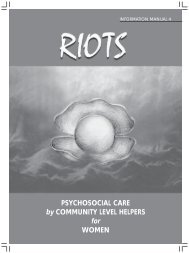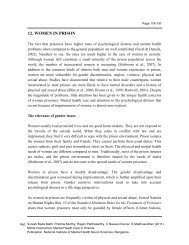An illicit alcohol production center in rural Bangalore - Nimhans
An illicit alcohol production center in rural Bangalore - Nimhans
An illicit alcohol production center in rural Bangalore - Nimhans
You also want an ePaper? Increase the reach of your titles
YUMPU automatically turns print PDFs into web optimized ePapers that Google loves.
45<br />
40<br />
35<br />
30<br />
25<br />
20<br />
15<br />
10<br />
5<br />
0<br />
The frequency of use however varies between men and women, with men dr<strong>in</strong>k<strong>in</strong>g more frequently<br />
than the women. However the difference though significant should be viewed aga<strong>in</strong>st the<br />
perspective that both men and women consumers were dr<strong>in</strong>k<strong>in</strong>g fairly frequently. While almost<br />
70% of the men drank daily or almost daily 55% of the women consumers did so too. This can<br />
hardly be termed “<strong>in</strong>frequent” dr<strong>in</strong>k<strong>in</strong>g. This is contrary to earlier reports that assert that the<br />
prevalent pattern is <strong>in</strong>frequent use of large quantities [Saxena,1999; Isaac,1998].<br />
The pattern that beg<strong>in</strong>s to emerge is that while the prevalence of <strong>alcohol</strong> dr<strong>in</strong>k<strong>in</strong>g is still fairly low,<br />
among those who do dr<strong>in</strong>k, consumption is fairly frequent and heavy.<br />
This is similar to what has been observed <strong>in</strong> Slavic and Scand<strong>in</strong>avian cultures [Room,2002]. The<br />
difference lies <strong>in</strong> the fact that the prevalence of users is still very low.<br />
Under-socialized and solitary dr<strong>in</strong>k<strong>in</strong>g of ma<strong>in</strong>ly spirits marks the pattern of dr<strong>in</strong>k<strong>in</strong>g; dr<strong>in</strong>k<strong>in</strong>g to<br />
<strong>in</strong>toxication and other features of dr<strong>in</strong>k<strong>in</strong>g found <strong>in</strong> dry cultures is the signature pattern<br />
39<br />
44<br />
Even<strong>in</strong>g<br />
(almost every<br />
day)<br />
19.5<br />
23<br />
Return<strong>in</strong>g<br />
home from<br />
work<br />
13.4<br />
12.4<br />
Dr<strong>in</strong>k<strong>in</strong>g Situations<br />
3.7<br />
Dr<strong>in</strong>k<strong>in</strong>g situations<br />
a. Sett<strong>in</strong>gs and activities associated with dr<strong>in</strong>k<strong>in</strong>g:<br />
The sett<strong>in</strong>g <strong>in</strong> which most dr<strong>in</strong>k<strong>in</strong>g occurred was essentially under-socialized and solitary. For men<br />
most dr<strong>in</strong>k<strong>in</strong>g appeared to occur after work, before com<strong>in</strong>g home, <strong>in</strong> male oriented pubs, bars or<br />
liquor shops essentially among strangers or dr<strong>in</strong>k<strong>in</strong>g acqua<strong>in</strong>tances. A fairly large number drank<br />
alone on streets or deserted places. Very rarely was dr<strong>in</strong>k<strong>in</strong>g done at home. Dr<strong>in</strong>k<strong>in</strong>g <strong>in</strong> bars or<br />
taverns are related to higher levels of dr<strong>in</strong>k<strong>in</strong>g and self reported dr<strong>in</strong>k<strong>in</strong>g problems (S<strong>in</strong>gle and<br />
Wortley, 1993). Respondents who predom<strong>in</strong>antly drank <strong>in</strong> bars, pubs or <strong>in</strong> solitude were<br />
significantly more likely to have a more hazardous pattern of <strong>alcohol</strong> use (estimated by scores on<br />
12.7<br />
Weekends Go<strong>in</strong>g out with<br />
friends<br />
4.9<br />
3.9<br />
Festivals,<br />
marriages, etc.<br />
17.1<br />
3.5<br />
Relax<strong>in</strong>g at<br />
home<br />
Female<br />
Male<br />
2.4<br />
Other<br />
0.6<br />
81





